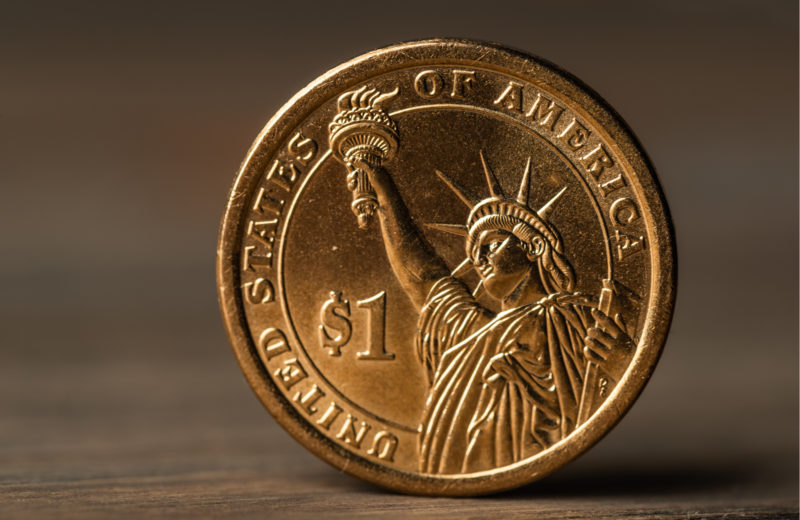The $1 Coin: World’s Worst Monetary Idea

There are a lot of bad monetary ideas floating around. Few are as awful as the American one-dollar coin, however. Despite almost fifty years of existence, the $1 coin has perennially failed to gain currency in the US.
Unfortunately, this particular bad idea hasn’t expired. Alaska’s governor has just signed a bill into law urging the U.S. Secretary of the Treasury to authorize the production of 5 million one-dollar coins for circulation in Alaska. According to Coinworld, this would amount to seven coins for each Alaskan.
It remains to be seen if Treasury Secretary Steven Mnuchin will acquiesce to Alaska’s request. No new $1 coin has been put into circulation since December 2011. That was when then-Treasury Secretary Timothy Geithner told the Federal Reserve to stop ordering $1 coins from the U.S. Mint.
Geithner had good reasons for putting a halt to the coin. Ever since it was first introduced in 1971, the $1 coin has been consistently unpopular with Americans, who prefer the sleek $1 note. After pushing new $1 coins into circulation, the Fed has typically found that all of them are quickly returned. Over a billion $1 coins currently sit unused in the Fed’s vaults. It’s a huge waste of resources and storage space.
You might think that the $1 coin is more cost effective than the $1 note. And so its usage should be promoted. But that’s actually not the case. Thanks to developments in note sorting and handling technology, the life of a $1 bill has been steadily extended so that it is more efficient than a coin.
Alaska has good intentions for issuing a $1 coin. It wants to honor native Alaskan civil rights activist Elizabeth Peratrovich, who championed passage of the Alaska Territory’s Anti-Discrimination Act of 1945.
In fact, last year the US Mint issued an Elizabeth Peratrovich coin for the collector’s market. (Geithner’s 2011 moratorium does not apply to $1 collector’s coins.) Collector’s coins are typically sold directly from the mint’s website at above-face value. That’s why the Mint is currently selling a roll of 25 Elizabeth Peratrovich $1 coins for $34.50 instead of $25.
But Alaska’s lawmakers want more than just a collector’s coin. They are asking for a circulating coin—one that is intended to be used in trade. This would involve the Fed buying five million Elizabeth Peratrovich $1 coins from the U.S. Mint. The discs would then be delivered to the Federal Reserve Bank of San Francisco, the Fed district bank that serves Alaska. And then, presumably, the San Francisco Fed would fly them up to Alaska and push them into circulation. (It would do this by providing them to commercial banks, upon which they will offer the $1 coins to the public at face-value.)
There’s more. Alaska is requesting the Treasury to “carry out a continuing campaign to encourage commercial enterprises to accept and dispense Elizabeth Peratrovich $1 coins.”
But all of this effort would likely be for nought. Some fifty years of history have taught us that the $1 coin format is very much unloved by Americans. All five million Elizabeth Peratroviches will quickly rebound to the Federal Reserve Bank of San Francisco, where they will remain in its vaults forever.
We should certainly celebrate minorities and women by putting their images on our money. It signifies the progress we have made. Moreover, when the notes and coins on which our heroes are depicted circulate through the economy, their stories are spread and reinforced. But a coin that doesn’t circulate doesn’t signal and can’t tell any stories! Instead, the $1 circulating coin has become a useless repository for the important legacies of women and minorities who have been portrayed on them over the years, including Susan B. Anthony, Sacagawea, and perhaps Elizabeth Peratrovich.
If Americans really want to make their money tell a broader array of stories, it’s probably time for the more popular banknotes to be updated. Most countries have long since revised their original note designs to include women. But Federal Reserve notes still display the same cast of characters that they did a hundred years ago.
This needn’t be the case. Grover Cleveland was dumped from the $20 in favor of Andrew Jackson in 1928. Today, we might shove Jackson out and replace him with someone else, like Harriet Tubman.
Alternatively, we could open the banknote market up to competition. Let the market drive what gets depicted on money.
What to do with the massive stock of unused $1 coins? In an earlier article, I suggested melting them all down. But here’s another suggestion. Venezuela is in the midst of informally adopting the U.S. dollar. While $20 bills are common enough, there seems to be a shortage of small change. These sorts of shortages are quite common in countries that have dollarized.
Why not send a plane load of unused $1 coins to the border? This would help cure Venezuela’s dollar shortage. We already know that $1 coins are popular in dollarized Ecuador, after all. Usage of the American dollar would spread while Venezuelan citizens would benefit from a more convenient medium of exchange. And the women and minorities depicted on those coins would be more properly respected. What’s not to love?









